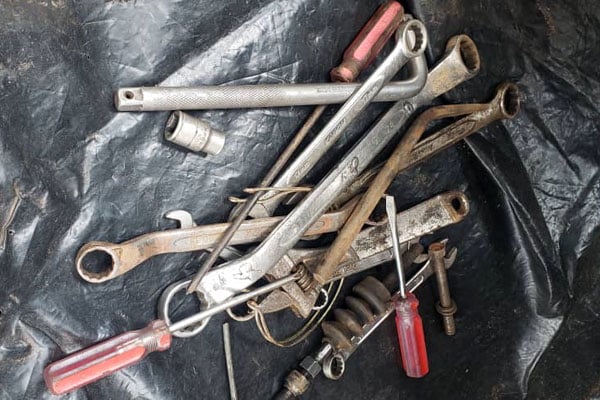Prime
Essential tools for a mechanic

These tools are essential in making repair works easier. PHOTO | DAPHINE NAKABIRI
What you need to know:
- A mechanic’s job can be made easier with the right tools. Without the right tools on hand, you will find it difficult to complete the tasks you need to perform without errors or delays.
Frank Kamulegeya is a mechanic at Lukusa & Son’s Garage in Bwaise, a Kampala suburb. He joined the garage in 2015 as an apprentice. As a fresher at the time, it was required of him to have a tool box because after sometime, he had become familiar with fixing most car problems.
“When I became fond of garage life and had developed some skills such as replacing tyres, diagnosing engine problems, replacing brakes, crutch problems, plugs and so on, I realised that my tool box had to have some essential tools. When someone borrowed any, I had to ensure I get them back.”
It is not only the mechanics that should have these tools. As a car owner, to relieve you of stress when you get stuck on the road after getting a flat tyre, it is important to have some of the basic tools here below.
Wrenches
Also known as a spanner, a wrench is a tool used to provide grid to loosen or tighten nuts and bolts. These come in different sizes such as 6, 8, 12 and are used to fit specific bolt and nut sizes.
Whereas some wrenches are open ended, others are double ended and both wrenches can either be in an L or T- shape. An example can be a ratcheting socket wrench. This tool works more efficient than other wrenches.
Screwdrivers
You never know when you need to remove a battery or change a headlight and you realise you need a screwdriver to help with the work. These essential tools are used for tightening or loosening screws.
The common types of screwdriver used in cars include flat and Phillips-head screwdrivers. The Phillips screwdriver has an X-like tip which is used to turn rotating screws to achieve a desired fit while the flat screwdriver has wedged shaped flat tip and can be used to tighten or loosen screws with a straight notch.
Pliers
There are various types of pliers and these include needle-nose, arch joint, combination, diagonal cutting, locking and so on. They are useful for gripping, tightening or loosening nuts, bending and cutting objects such as wires.
Typically, the most commonly used pliers are the combination and needle-nose. The jaw of the combination pliers contains a flat and serrated holding hole and a wire-cutting blade. The flat part keeps the objects flat, and the jagged ones hold the rounded objects. The needle-nose pliers have long jaws that are great for reaching tight spaces and holding small parts
Hammer
Whereas there are several types of hammers such as the brick, claw or sledge one can choose to use depending on their need, mechanics use what is commonly known as the machinist hammers.
These hammers include the straight peen, ball peen and cross peen hammers, door skinning. They are used to remove dents from panels and vehicles or reversing curves.
Jack and jack stand
When you need to replace a car tyre wheel or brake pads, you need to lift your car to do the work. The purpose of the jack is to raise the vehicle, but the jack stand holds the vehicle off the ground while working underneath.
The jack uses hydraulics to lift and are susceptible to failure if left under constant pressure, especially if not properly maintained. “Be sure to place the jack in a safe spot that you know can support the weight of the vehicle, without it slipping off the jack stand,”Kamulegeya warns.
Multimeter
It is a handheld device that measures electrical voltage, current and resistance in a vehicle. These are measured typically in units of volts, amps and ohms respectively. It is used for diagnosing car electrical issues such as the strength of your car battery, rogue circuits or determining issues with headlights.
Safety gears
These equipment provide protection against against hazards such as injury, infection or dirt. They include gloves, safety glasses, earmuffs and ear plugs. Kamulegeya says, “It is also important to wear work boots while at work because one time a vehicle trod on my foot causing severe pain.”
Diagnostic tools
These are code readers or scanners used for identifying issues in car parts like the engine, ignition system, transmission, oil tanks and so on in modern vehicle through the offset deformable barrier OBD-II port.
For instance, if your car displays an engine warning light, you might not know whether there the problem is with the spark plugs or it’s the engine failing, you will thus need a mechanic to read the codes and know what exactly the problem is.
These scanners include, On-board diagnostics (ODB) car scanners, tyre pressure monitoring systems (TPMS), car battery testers and so on.
Oil filter wrench
This is a tool designed to remove and replace spin-on oil filters during oil changes. Different types of oil filter wrenches have different mechanisms for spinning and thus as a mechanic it is important to know which is most appropriate depending on the types of vehicles you work on. The oil filter wrenches include band, socket filter, chain loop, floor and strap wrenches.
Brake bleeder kit
Kamulegeya says usually large vehicles or manual cars are fond of having problems with clutches and brakes getting filled with air. In the bid, as a mechanic you need such a specialised tool to help in getting rid of air bubbles as it is essential for bleeding brake lines to remove air, changing brake fluid and maintaining braking performance.




